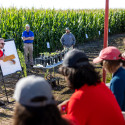Students offer neighborhood design suggestions
Inside every rubble-infested, garbage-strewn, rodent-molested urban backlot is an inviting city square waiting to break free.
Perhaps it is waiting for Sarah Schultz, one of 20 students in Martin Bailkey’s landscape architecture classes. The courses require students to design ways to improve spaces in inner-city Milwaukee.
Schultz, who plans to graduate in May with a bachelor’s in landscape architecture, is working with the Midtown Neighborhood Association and the National Park Service to create a vision of what a vacant lot on Milwaukee’s Walnut Street might become and of the uses it might serve.
Schultz says that the reception the organizations have given her plans has been most encouraging.
“They seem to be especially excited about using my plans for fund raising and development,” she says. “For example, the MTNA may use my neighborhood center/square/marketplace ideas to encourage developers to invest in the area.”
Mark Weaver, community planner for the National Park Service, has worked with Schultz for several months. He says he’s been quite impressed by the quality of the work she and her fellow students have submitted, and has no doubt community groups will find the designs helpful.
“An actual, physical plan for a project says to funding agencies, ‘This organization really has its act together.’ But to have a professional consultant design something usually costs more money than these groups have, so the students are really providing a valuable service in terms of getting a vision for an area started,” he says. “Once funding is obtained, an organization can go ahead and hire the professionals needed to complete the project.”
Last semester, one student submitted concept plans to the Portage Canal and Trail societies for developing the Portage Canal as a recreational resource, Weaver says. The two organizations are pursuing funding for the designs.
Bailkey says the unbeatable real-world contact his classes are making more than absorb the inconvenience of trekking to Milwaukee at least four times a semester.
“I wanted to nudge our department in this direction for some time,” he says. “As Wisconsin’s only accredited landscape architecture program, we should strengthen the role of landscape architects in the core of the state’s largest urban center. And working in the inner city presents our students with special challenges they won’t encounter in other academic situations.”
Schultz seconds that sentiment most emphatically: “Working on this project has helped me get ready for a professional job more than any typical classroom experience ever could have,” she says. “I’ve learned about my own limitations, dealing with busy clients who don’t know me from John Doe, and I’ve made some valuable contacts. I’ve learned about the real world while still having a safety net in the academic one.”
Along with landscape architecture colleagues John Harrington, Evelyn Howell and Janet Silbernagel, Bailkey has just received a UW–Madison Teaching Enhancement Grant to further adapt courses to address inner-city needs. The grant team is examining design courses to determine which will lend themselves to the grant’s mission. They also are scouting neighborhood and other organizations in the Milwaukee area for next semester.
Tags: learning




